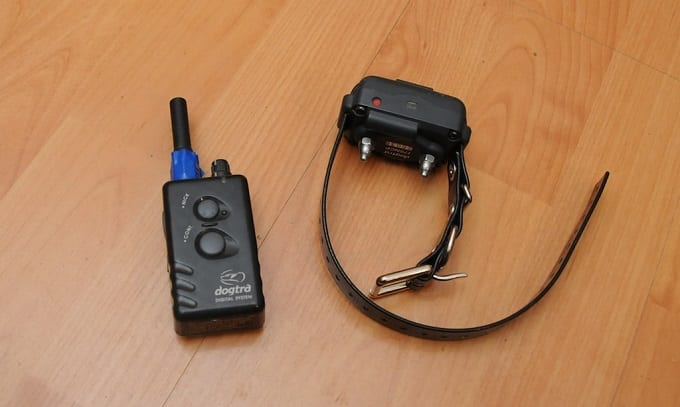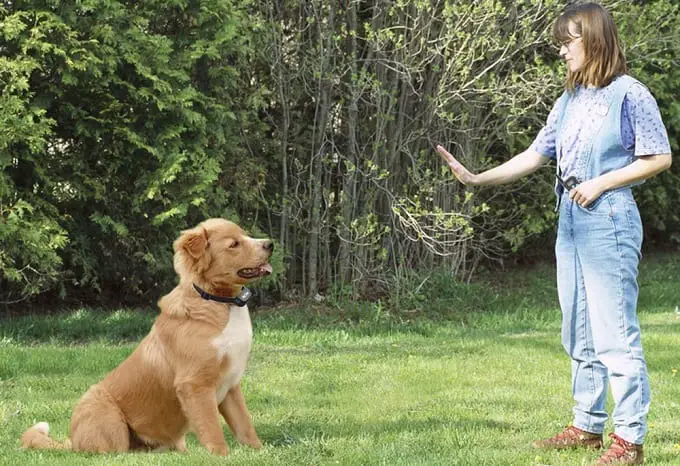Using shock collars, also called training collars or electronic collars, helps a dog grasp and retain important skills.
Shock collars can be very useful if they are properly used.
However, many dog owners use them as a substitute for normal training techniques, which may not be the best solution, especially for young dogs.
Shock collars also come with a bit of controversy, so before you start to use a shock collar as a training device, it is important that you fully understand the pros and cons of this tool and the perceptions that some people may have about these handy tools.
One of our first bits of advice about using a shock collar to train your dog is that you should start with regular, or traditional training techniques first.
Teaching your dog the basics using the positive reinforcement technique or a similar training style will help your dog get used to the commands that you will want to use in further training.
Additionally, basic obedience is helpful when you start using a shock collar, as a way to bring the focus back to your pup.

Making sure that they have at least some basic understanding of simple commands like “sit”, “down”, “stay” and “come” will make training your dog easier.
Our second bit of advice regarding shock collars is to remember that these tools can be, and often are considered “mean” or “inhumane”.
For experienced trainers, and trainers that are teaching dogs critical skills, the use of a shock collar or electronic collar are often essential tools.
They are also harmless, and quite safe to use when they are used correctly and with the well-being of your dog as your first priority.
To help you navigate through the use of a shock collar, especially if it is your first time using one as a training tool, we’ve put together this handy guide to using an electronic collar.
Keep in mind, that there are always a variety of techniques and processes that work well.
We are providing you with the basics of using a shock collar. If you find that these basics don’t work well for you or your pup, we recommend consulting with a professional trainer.
As with any training techniques, these are the experts and they can give you individualized assistance, should you need.
How Do You Teach Your Dog Using a Shock Collar?
Before we start on our tips and process for training your dog using a shock collar, we again want to emphasize the importance of using these tools with kindness.
Shock collars can be incredibly useful and SAFE tools for training your dog. In many ways, they are safer and gentler than traditional collars and harnesses.
However, in the hands of an unaware person, or less than a patient person, a shock collar can become a very painful and frightening experience for your dog.
If you aren’t sure how to use one properly, consult a professional trainer, or hire a professional trainer to train your dog with a shock collar.
Here are the steps that we recommend for using a shock collar as a training tool.
Purchase a Quality Product

This is a really important step in training your dog with a shock collar. A good tool will make your life, and your pup’s life so much more enjoyable.
There are lots of great products on the market, and they come in a variety of price ranges, with a variety of options.
Do your research before you invest. You may not need all the bells and whistles, and spending a ton of money on something you can utilize well, as well, a waste of money.
Start with the basics
This means all the basics. Don’t start training your new puppy, right off the bat with a shock collar. It won’t work, and both you and your puppy will be frustrated.
Use basic, traditional training techniques to teach your dog the basic commands that they will need, to be polite members of society.
Learning the basics first, in a simple and easy to understand way, will build a trusting relationship between you and your dog, and will help them learn how to learn.
Let your dog get used to the collar first
Let your dog wear the collar without any corrections. Shock collars feel different from other collars, so give your pup a chance to get comfortable wearing the tool.
Show your dog the behavior you want
If you expect behavior from your dog, but you don’t tell them what you want, just correcting them with the shock collar isn’t going to do a bit of good.
Show your dog the behavior you’re looking for. This is going to be a repetitive process and may take a few weeks.
Use treats, specific words, and the shock collar to reinforce the behavior you want. Pretty soon, you can use just a cue on the shock collar to ask your dog to do a particular skill.
Back-up the shock collar with other techniques

Here’s the scoop, if your dog only knows how to do a skill using a shock collar, you won’t be able to get him to do anything if he isn’t wearing the shock collar.
Make sure you use a variety of training techniques, like positive reinforcement, clickers, negative response training, etcetera, so that if you’re just out with a collar or a harness, your dog still knows what to do when you make a request.
Aim to use “vibrate” or no collar at all
Most dogs really want to please their owners. Honestly, your dog sees this as his job – to make you happy.
So, when you chose to use a shock collar for training your dog, your eventual goal is to have a dog that is so well trained, that you can leave the shock collar behind, or use the vibrate setting only.
Because this is your goal, we again emphasize the importance of using other techniques, along with the shock collar.
Done correctly, shock collar training can eliminate problem behaviors, or create helpful skills, and eventually eliminate the need for the shock collar altogether.
If you get here, then you’ve done your job right!
Know when to ask for help
Before you get frustrated and get tempted to give up, or worse, turn the correction level all the way up, ask for help.
Many professional dog trainers are highly skilled in using shock collars. If you are struggling, don’t give up, ask for help.
Yes, you’ll probably have to pay for the help, but professional trainers can give you all sorts of great tips and tricks to make using a shock collar easy and successful for both you and your pup.
One final reminder

Unless you’re in a life or death situation (your dog just bolted towards a busy highway) you should never need to use the highest correction level on your shock collar.
Most shock collars come with a range of correction levels. Many have a vibrate setting, along with a range of electric shocks that increase in intensity.
Most dogs will correct behavior or learn a behavior using the lowest levels of correction. However, sometimes just like people, dogs can be stubborn.
If your dog isn’t responding to a lower correction level, slowly increase the level, until you reach a point that gets your dog’s attention.
Generally, this will be just a level or two from where you started. Using the highest level of correction to teach basic skills or to correct an undesirable behavior is not training.
It is mean, and your dog won’t learn a skill. They’ll just learn to be afraid of you.
What Can You Teach Your Dog Using a Shock Collar?
Since shock collars are such handy tools, but you might be surprised at the variety of skills that your dog can learn from using an electronic collar.
Let’s start with the basics

Shock collars are a great tool to help improve your dog’s mastery of basic obedience skills.
Knowing basic obedience is really the first step to training your dog more complicated skills, or skills that will allow your dog to do a job.
Being an expert in the basics will make it easier for your dog to learn more advanced skills.
Using a shock collar later in your dog’s obedience training can help solidify skills they already know, and make them more confident.
Off-Leash Walking
This is another good skill to use a shock collar to help your pup learn.
Many communities recognize that electronic collars are a good alternative for physical leashes, and recognize them as an acceptable leash.
In some situations, you may want to walk your dog off leash for both convenience and safety.
Using an electronic collar to help your dog learn voice commands when walking off leash will make them easier to control, while at the same time giving your dog a bit of freedom.
Shock collars for off-leash control are especially handy at busy dog parks, where a leash can become a dangerous “weapon” of sorts.
Correct Problem Behaviors

Sometimes our dogs just do dumb stuff. Stuff that makes them less than polite members of our families or social groups.
These behaviors are often times the most difficult to teach your dog to not do. A shock collar is a helpful tool to help your dog stop doing those naughty things that make them, well, jerks.
For instance, if your dog barks like a maniac every time it goes to the backyard, using a shock collar when the bark can help your dog learn that barking is undesirable behavior.
Over time, after consistent use of a shock collar, your dog may learn that barking about nothing, is a dumb thing to do.
Hunting
Many people that are intending on using their pup for a hunting dog start training their dog with an electronic collar at an early age.
Today’s shock collars often come with a variety of signals that you can use to teach a specific response.
Hunters don’t want to be shouting signals to their dog while tracking an animal, so a shock collar can give a silent cue to a well-trained hunting dog about the work their owner wants them to do.
Agility Training
Agility training often requires a handler to send quick signals to a dog and sometimes shouting these commands don’t work as effectively as the handler would like.
Like with hunting training, shock collars can be used to give specific commands to dogs, without yelling, and in a quick manner.
Specialty Jobs
Specialty jobs are one of the places where shock collars excel as a training tool.
Dogs that are being trained for a variety of specialty jobs, especially ones that may put both the dog and handler in danger, can really benefit from training using a shock collar.
Most of us aren’t training our dogs how to be bomb-sniffing dogs, or police or military dogs, though in these training applications shock collars are extensively used.
However, there are specialty jobs that your dog can train for, at home, and may demand the use of a shock collar.
Examples of these kinds of jobs can include search and rescue dogs, avalanche dogs, and corpse detection dogs.
These jobs can put both the owner and handler in danger, so an effective way of communicating can be life-saving in dangerous situations.
Shock collars can be a great training tool for the dog owner that wants to take their dog’s skills to the next level.
Not only are they an incredibly effective tool for teaching your dog, but they can also be a great tool for keeping your dog safe.
Using a shock collar to teach your dog new skills or correct poor behaviors can turn your dog from “just another dog,” to a rockstar of a pup!
Do you have suggestions for how to help make at home shock collar training successful?
Share them with us in the comments.
